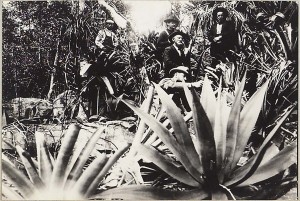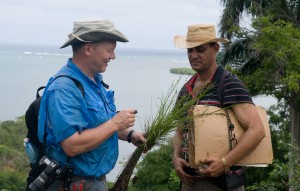Cuba and The New York Botanical Garden
Posted in Science on March 11 2010, by Plant Talk
A Century of Plant Exploration and Research
 |
Brian M. Boom, Ph.D., is Director, Caribbean Biodiversity Program, and Melissa Tulig, is Associate Director of the Herbarium at The New York Botanical Garden. |
 The Orchid Show: Cuba in Flower in the Enid A. Haupt Conservatory provides an excellent occasion to draw attention to the Botanical Garden’s long history of plant exploration in Cuba and the Garden’s current scientific activities on the largest and most biologically diverse island in the Caribbean.
The Orchid Show: Cuba in Flower in the Enid A. Haupt Conservatory provides an excellent occasion to draw attention to the Botanical Garden’s long history of plant exploration in Cuba and the Garden’s current scientific activities on the largest and most biologically diverse island in the Caribbean.
Beginning in 1903 and as recently as October 2009, the Garden has collaborated with Cuban botanists and institutions in documenting and studying the Cuban flora, collecting more than 20,000 specimens on 23 expeditions. The Garden’s research in Cuba is active and ongoing.
(The black-and-white photo above from the Mertz Library Archives is from an expedition to the Isle of Pines in Cuba led by the Garden’s founder Nathaniel Lord Britton in 1916. The photo below, by Garden scientist Fabián A. Michelangeli, Ph.D., is from the most current expedition and shows Garden scientist Wayt Thomas, Ph.D., at left, with his Cuban student Waldo Bonet collecting sedges.)
 One good way to tell this story of more than a century of plant exploration in Cuba is through the more than 12,500 digitized specimen records currently available via the Garden’s C.V. Starr Virtual Herbarium. Some newly created Web features allow easy access to these data, and we recommend trying the following to explore the Garden’s history in Cuba and some of the plant diversity on the island as told by the specimens.
One good way to tell this story of more than a century of plant exploration in Cuba is through the more than 12,500 digitized specimen records currently available via the Garden’s C.V. Starr Virtual Herbarium. Some newly created Web features allow easy access to these data, and we recommend trying the following to explore the Garden’s history in Cuba and some of the plant diversity on the island as told by the specimens.
The Web page Garden Scientists in Cuba provides an overview of the program and includes an interactive map of Cuba. The red place marks indicate a sampling of native Cuban orchid species, mapped to the level of province, and the blue place marks indicate a sampling of specimens of other plant families collected on the Garden’s October 2009 expedition. Clicking on a species name takes you to the specimen record and image.
To learn more about the entire range of Cuban plant specimens available at the Garden, visit a new Web page on the Caribbean Biodiversity Portal that lists the 23 Cuban expeditions of the Garden and links to several specimen showcases, the first comprising a sampling of 65 specimens collected across the island over the years and additional specimen showcases featuring hundreds of specimens organized around four historical Garden scientists (N.L. Britton, E.G. Britton, J.A. Shafer, and P. Wilson) and two contemporary Garden scientists (F.A.. Michelangeli and W.W. Thomas). Click on their names to learn more about them, and on the word “Cuba” following their names to see specimens they collected.
Once in the specimen showcases, we recommend selecting “Contact Sheet View” for best browsing, and “Map View” to visualize geographic distributions, for those specimens with localities that have been mapped so far. From “Map View” you can click on the underlined plant name in the balloon that appears when you click on a red place mark to be directed to the specimen record itself.
Also from the Caribbean Biodiversity Portal, you can explore on your own by using advanced search to query the database for specimens from Cuba. You can learn about the Garden’s current conservation project involving Cuban plants by clicking “Projects” on the bar at the top of the page and then scrolling down to the project, Habitat Specificity of Selected Endemic Cuban Plant Species.
We hope you visit The Orchid Show: Cuba in Flower to experience the splendors of the exhibition in person. We hope, too, you will visit Garden Scientists in Cuba to learn more about Cuba’s native flora as documented by The New York Botanical Garden and Cuban colleagues, and to begin your own journey.

